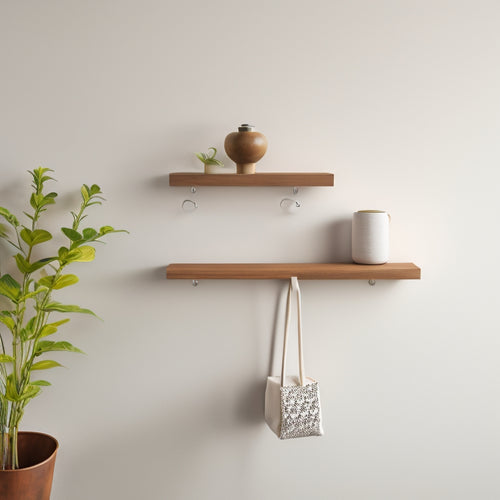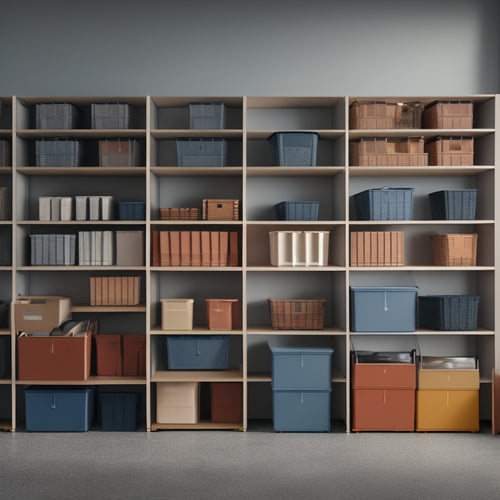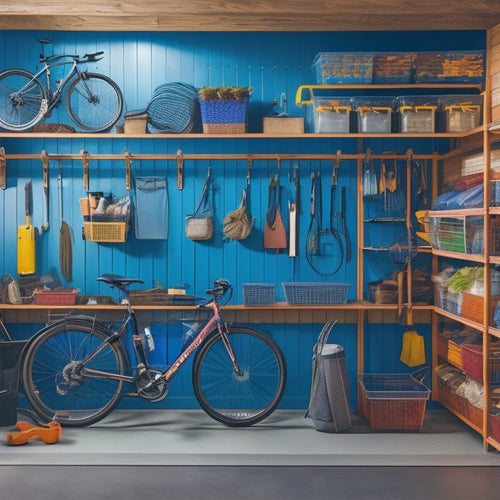
10 Essential DIY Workshop Furniture Building Plans
Share
You're looking to optimize your workshop's productivity and efficiency. Start by building a space-saving workbench that fits your unique needs, like a foldable or wall-mounted design. Next, create a tool organization station with a customizable pegboard system and compact shelves for storage. Don't forget a mobile work cart solution to keep your workflow moving. Modular cabinet building plans will help you maximize vertical storage, and a compact clamp station design will keep your most-used tools within reach. With these essential DIY workshop furniture building plans, you'll be well on your way to creating a tailored workspace that boosts your productivity - and there's more to explore.
Key Takeaways
• Design a space-saving workbench with folding capabilities to maximize workshop floor space and versatility.
• Build a tool organization station with customizable pegboard systems and DIY shelving units for efficient storage.
• Create a mobile work cart solution to increase workshop mobility and flexibility.
• Incorporate ergonomic workstation ideas to reduce fatigue and improve productivity.
• Construct a compact clamp station design to keep clamps organized and within easy reach.
Space-Saving Workbench Designs
Design a space-saving workbench that fits your compact workshop or garage by incorporating foldable, wall-mounted, or mobile features that maximize your available floor space. This will enable you to work efficiently without sacrificing valuable space.
Consider portable workbench innovations that allow you to easily move the workbench around the workshop or garage, providing flexibility and convenience. Folding worktable features are also a great option, as they can be easily stowed away when not in use, freeing up floor space for other projects.
Another key consideration is adjustable height advantages. A compact workbench with adjustable height settings will allow you to work comfortably, reducing fatigue and strain. Look for designs that offer a range of height settings to accommodate different tasks and user preferences.
Additionally, compact workbench benefits include reduced material costs and a more organized workspace. By incorporating these space-saving features, you'll be able to create a functional and efficient work area that meets your specific needs.
With a little creativity and planning, you can build a workbench that works for you, not against you.
Tool Organization Station Plans
With your compact workbench in place, you can now focus on creating a tool organization station that keeps your equipment within easy reach, saving you time and streamlining your workflow. A well-designed tool organization station is essential for efficient work.
Start by evaluating your tool collection and categorizing them based on frequency of use and type. Next, plan the layout of your station, considering the space available and the tools you need to store.
For maximum storage, consider building a tool cabinet with adjustable shelves and dividers. You can also add DIY workbench upgrades such as a slide-out drawer or a pegged board for hanging tools.
When organizing your tools, prioritize the most frequently used ones, placing them in easy-to-reach locations. Use bins and baskets to store small items like screws, nuts, and bolts.
A well-organized tool station won't only save you time but also reduce frustration and improve your overall work experience. By following these steps, you'll be able to create a functional and efficient tool organization station that meets your specific needs.
Customizable Pegboard Systems
You can maximize your tool organization station's potential by incorporating a customizable pegboard system that lets you tailor the layout to your specific tool collection and workflow needs. This is especially useful for DIY enthusiasts who have unique tool sets or prefer a specific arrangement for their tools. With a customizable pegboard system, you can create a layout that suits your work style and optimizes your tool display.
Here are some DIY pegboard accessories you can create or purchase to enhance your pegboard organization:
| Accessory | Description | Benefits |
|---|---|---|
| Custom Hooks | Hooks designed for specific tools, such as hammers or saws | Easy tool access, reduced clutter |
| Tool Holders | Holders for small tools, like pliers or screwdrivers | Keeps tools organized, saves space |
| Bin Organizers | Bins for storing small parts or supplies | Reduces clutter, simplifies inventory management |
| Adjustable Pegs | Pegs that can be moved or adjusted to fit different tool sizes | Versatile, accommodates changing tool collections |
Mobile Work Cart Solutions
To take your tool organization to the next level and create a more efficient workspace, contemplate incorporating mobile work cart solutions that can be easily moved around your workshop to support your various projects and tasks. A well-designed rolling work cart can help you stay organized, reduce clutter, and increase productivity. When building your DIY work cart, choose material options that are durable, easy to clean, and resistant to scratches and dents. Contemplate using heavy-duty wheels, a sturdy frame, and a smooth countertop.
For assembly tips, start by building the frame, then add the wheels, shelves, and countertops. Make sure to leave enough space for your tools and supplies. You can also add dividers, bins, and hooks to customize your cart to your specific needs. Don't forget to contemplate the weight capacity and stability of your cart to ensure it can hold all your tools and equipment.
With a little creativity and planning, your mobile work cart will become an essential tool in your workshop, helping you stay organized and focused on your projects.
DIY Shelving Units for Storage
When building DIY shelving units for storage, you'll want to weigh the advantages of an adjustable shelf design. This will allow you to customize the layout to fit your specific needs.
You'll also benefit from incorporating space-saving corner units that maximize every inch of your workshop.
Adjustable Shelf Design
Best storage and flexibility come together in an adjustable shelf design, allowing you to customize your DIY shelving units to accommodate items of varying sizes and shapes. With adjustable shelf placement, you can easily move shelves up or down to fit items of different heights. This feature is especially useful when storing items like bins, baskets, or containers that come in different sizes.
To add an extra touch of personalization, consider custom wood finishes that match your workshop's aesthetic. You can choose from a variety of finishes, such as oak, walnut, or pine, to create a cohesive look. Additionally, removable shelf accessories like baskets, hooks, or bins can enhance the functionality of your shelving units. These accessories can be easily added or removed as needed, making it simple to adapt your storage space to changing needs.
When building your adjustable shelves, consider incorporating shelf height options. This can be achieved by using slotted holes or adjustable shelf pins that allow you to customize the shelf height. By doing so, you'll be able to store items of different sizes and shapes, making the most of your workshop's storage space.
Space-Saving Corner Units
You can maximize your workshop's often-wasted corner spaces by building space-saving corner units that provide ample storage and keep your tools and materials organized. These units are especially useful for small workshop layouts, where every inch counts. By installing DIY corner desks or shelving units, you can create a functional corner workspace that boosts your productivity.
When designing your space-saving corner unit, consider the items you need to store and the frequency of use. Install shelves or cabinets that are easily accessible, and reserve the top shelves for less frequently used items. You can also add a pegboard or hooks to hang tools, freeing up floor space.
To guarantee efficient workshop design, measure your corner space carefully and plan your unit accordingly. Consider using adjustable shelves or baskets to accommodate items of varying sizes. With a well-designed corner unit, you'll be able to find what you need quickly, saving time and reducing frustration.
Customizable Storage Options
Frequently, your workshop requires adaptable storage solutions that can be tailored to your unique needs, and DIY shelving units offer the perfect answer, allowing you to customize your storage capacity and layout as your projects evolve.
By building your own shelving units, you can create a storage system that grows with your workshop. Consider incorporating rolling toolboxes and DIY cabinet organizers to maximize your storage space. These mobile units can be easily moved around the workshop, providing quick access to your tools and supplies.
To optimize your vertical space, build vertical lumber racks that can hold long pieces of wood, pipes, or other materials. These racks are especially useful for storing items that are infrequently used, keeping them out of the way but still accessible.
Don't forget to utilize overhead storage solutions, such as ceiling-mounted racks or bins, to store items like seasonal decorations, out-of-season tools, or other items that take up valuable floor space.
Ergonomic Workstation Ideas
Designing an ergonomic workstation begins with evaluating your body's needs and the tasks you'll be performing at the workstation, guaranteeing a comfortable and efficient working experience.
You'll want to contemplate the height and layout of your workstation to accommodate your standing or sitting preferences. A standing desk, for instance, can help improve posture and reduce back strain. When setting up your workstation, incorporate tool holders to keep frequently used tools within easy reach, reducing strain on your back and shoulders.
Take into account the types of tasks you'll be performing and design your workstation accordingly. If you'll be working with power tools, make sure you have adequate space and a stable surface to support the tools. You may also want to integrate a vice or clamp system to keep your workpieces secure.
Additionally, think about the type of lighting you'll need and position it to reduce glare and eye strain. By taking these factors into account, you can create an ergonomic workstation that meets your specific needs and promotes a comfortable, efficient working experience.
Modular Cabinet Building Plans
Your workshop's storage needs can be met with modular cabinet building plans that allow you to customize your storage space and maximize your workshop's efficiency. With modular storage, you can create a system that adapts to your specific needs, making the most of your available space.
You can choose from various cabinet sizes and styles to create a tailored solution that suits your DIY furniture requirements.
When building your modular cabinets, consider the type of items you'll be storing. For example, if you need to store large power tools, design your cabinets with deeper shelves and larger doors. On the other hand, if you're storing smaller items like hand tools or fasteners, opt for narrower shelves and smaller drawers.
By customizing your cabinet organization, you'll be able to find what you need quickly and easily, saving you time and increasing your workshop's efficiency.
With modular cabinet building plans, you can create a storage system that's both functional and flexible, ensuring your workshop runs smoothly and efficiently.
Compact Clamp Station Designs
With your modular cabinet storage system in place, you can now focus on creating a compact clamp station that keeps your clamps organized and within easy reach, freeing up valuable workspace and streamlining your workflow.
A well-designed clamp station is essential for any DIY enthusiast or woodworker, as it allows you to quickly access the clamps you need, saving time and reducing frustration.
To create a compact clamp station, start by building a clamp rack that can hold multiple clamps of different sizes. You can use a pegboard or a slotted board to hang your clamps, keeping them organized and visible.
Consider adding DIY tool holders, such as small bins or trays, to store clamp accessories like jaws, pads, and bars. When designing your clamp station, keep in mind space-saving ideas, like using wall-mounted or foldable designs to maximize your workshop's floor space.
Remember to incorporate organization tips, such as labeling your clamps and grouping similar types together, to make your clamp station functional and efficient.
Folding Workbench Projects
You'll appreciate the versatility of a folding workbench, which allows you to create a temporary workstation wherever you need it, freeing up floor space when not in use. With portable workbench solutions, you can set up a DIY folding table in a snap, providing a stable surface for various projects.
When designing your collapsible work surface, consider the materials and mechanisms that will guarantee stability and ease of use. Opt for space-efficient workbench solutions that can be easily stowed away when not in use. Look for DIY folding table ideas that incorporate clever storage compartments, keeping your tools and supplies within reach.
You can also incorporate casters or wheels to make your workbench even more mobile. When building your folding workbench, pay attention to the hinges and legs, guaranteeing they can support the weight of your projects. Consider adding a vice or clamping system to keep your materials secure.
With a well-designed folding workbench, you'll be able to tackle projects of all sizes, anywhere in your workshop.
Multi-Functional Worktable Ideas
Create a multi-functional worktable that adapts to your project needs by incorporating features like built-in storage bins, adjustable shelving, and removable trays. This will enable you to efficiently switch between tasks and projects, maximizing your workshop's productivity.
When designing your multi-functional worktable, consider the following features:
-
Modular workbench accessories: Incorporate interchangeable modules that can be easily swapped out to accommodate different tasks, such as a vice, a drill press, or a measuring station.
-
Storage solutions: Add built-in bins, drawers, or shelves to store tools, materials, and supplies, keeping them within easy reach.
-
DIY assembly tables: Design a table with removable trays or surfaces that can be easily cleaned and replaced, ideal for messy projects or tasks that require frequent surface changes.
-
Tool holders: Integrate tool holders or pegboards to keep frequently used tools organized and within arm's reach.
-
Ergonomic considerations: Incorporate features that promote comfortable working, such as adjustable height, built-in wrist rests, or a sloping surface to reduce strain on your back and neck.
Frequently Asked Questions
What Safety Precautions Should I Take When Working With Power Tools?
"Ha! You think you're a DIY rockstar, but without safety precautions, you'll be a hot mess! You're smart, so put on those safety goggles and ear protection, and don't forget proper ventilation and a dust mask - your future self (and others) will thank you!"
Can I Use Reclaimed Wood for Building My Workshop Furniture?
You can use reclaimed wood for your project, enjoying benefits like unique character and eco-friendliness, but be aware of limitations like potential damage, rot, and pest infestations, and take steps to inspect and treat the wood properly.
How Do I Ensure Accurate Measurements in My DIY Projects?
'Measure twice, cut once' is more than a mantra - it's a recipe for success! You'll guarantee accurate measurements by wielding precision tools, mastering marking techniques, double-checking your work, and maintaining consistency in every calculation.
What Type of Finish Is Best for Protecting My Workshop Furniture?
When choosing a finish for your project, you'll want to weigh oil vs lacquer for a natural look or polyurethane vs varnish for durability. Lacquer dries fast, while oil provides a soft sheen; polyurethane is water-resistant, and varnish offers a glossy finish.
Can I Customize DIY Plans to Fit My Specific Workshop Needs?
You can customize DIY plans to fit your specific workshop needs by tailoring designs to maximize space and optimizing workflow, ensuring your furniture serves you and your unique requirements.
Related Posts
-

Wall Mounted Hooks With Shelf for Maximum Storage
You'll find that wall mounted hooks with a shelf are a revolutionary solution for maximizing storage in your home, pr...
-

Choosing the Right Stacked Storage Bins
When choosing the right stacked storage bins, you'll want to evaluate your storage needs, considering inventory types...
-

Garage Wall Storage Ideas to Boost Productivity
You can enhance your garage's productivity by capitalizing on your ceiling height with overhead racks, storing bulky ...


